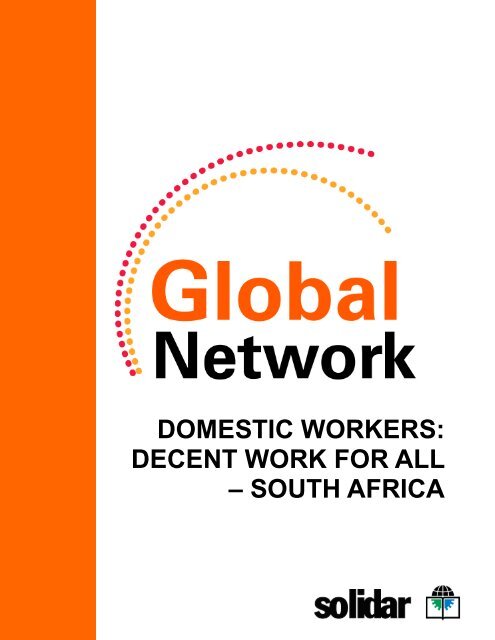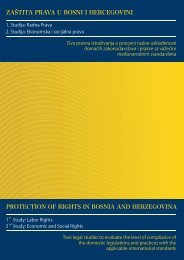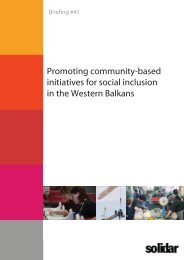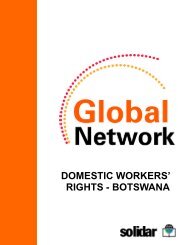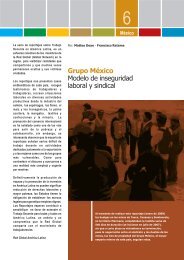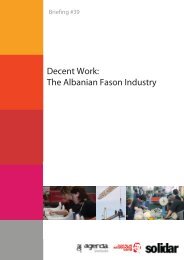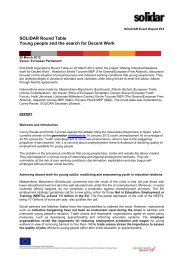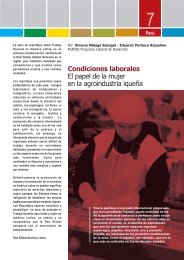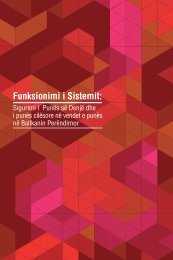domestic workers: decent work for all â south africa - Solidar
domestic workers: decent work for all â south africa - Solidar
domestic workers: decent work for all â south africa - Solidar
You also want an ePaper? Increase the reach of your titles
YUMPU automatically turns print PDFs into web optimized ePapers that Google loves.
DOMESTIC WORKERS:<br />
DECENT WORK FOR ALL<br />
– SOUTH AFRICA
INDEX<br />
1. Role of <strong>domestic</strong> <strong><strong>work</strong>ers</strong> in the economy ........................................................................... 3<br />
2. Wages and conditions of <strong>domestic</strong> <strong><strong>work</strong>ers</strong> in South Africa .............................................. 6<br />
3. Organisation of <strong>domestic</strong> <strong><strong>work</strong>ers</strong> in South Africa .............................................................. 9<br />
4. What has SADSAWU done in preparation <strong>for</strong> an ILO Convention? ................................. 11<br />
5. Recommendations………………………………………………………………………………...12<br />
6. References………………………………………………………………………………………….. 13<br />
THE GLOBAL NETWORK<br />
With the aim of achieving <strong>decent</strong> <strong>work</strong> <strong>for</strong> <strong>all</strong>, the Global Net<strong>work</strong> <strong>work</strong>s to empower women and<br />
men who are activists in NGOs, trade unions, associations of in<strong>for</strong>mal <strong><strong>work</strong>ers</strong> and grassroots<br />
movements to build capacity, exchange experiences and coordinate joint actions, at both<br />
regional and international level.<br />
WWW.THEGLOBALNETWORK.NET<br />
This publication has been produced with the assistance of the European Union under the<br />
project Globalising Decent Work and by UKaid from the Department <strong>for</strong> International<br />
Development. The contents of this publication are the sole responsibility of the publisher and<br />
can in no way be taken to reflect the views of the European Union nor UKaid/DFID.<br />
GLOBAL NETWORK 2
1. Role of <strong>domestic</strong> <strong><strong>work</strong>ers</strong> in the economy<br />
In terms of the International Standard Classification of Occupations of the International Labour<br />
Organization (ILO), <strong>domestic</strong> <strong>work</strong> f<strong>all</strong>s under at least two classifications: ―housekeeping‖ of a<br />
relatively skilled and supervisory nature (including cooks, childcare <strong><strong>work</strong>ers</strong> and home-based<br />
personal care <strong><strong>work</strong>ers</strong>) 1 and ―<strong>domestic</strong> cleaners and helpers‖ whose tasks include:<br />
• Sweeping, vacuum-cleaning, polishing and washing floors and furniture, or washing<br />
windows and other fixtures;<br />
• Washing, ironing and mending linen and other textiles;<br />
• Washing dishes;<br />
• Preparing, cooking and serving meals and refreshments;<br />
• Purchasing food and various other household supplies;<br />
• Cleaning, disinfecting and deodorising kitchens, bathrooms and toilets;<br />
• Cleaning windows and other glass surfaces. 2<br />
In South Africa, the Basic Conditions of Employment Act defines a <strong>domestic</strong> <strong>work</strong>er as an<br />
employee who per<strong>for</strong>ms <strong>domestic</strong> <strong>work</strong> in the home of his or her employer and includes a<br />
―gardener‖, a ―person employed by a household as a driver of a motor vehicle‖ and a person<br />
―who takes care of children, the aged, the sick, the frail or the disabled‖. 3 A distinguishing<br />
feature of <strong>domestic</strong> <strong>work</strong> is that it is per<strong>for</strong>med by individual <strong>domestic</strong> <strong><strong>work</strong>ers</strong> in private homes.<br />
In many instances the <strong>domestic</strong> <strong>work</strong>er also lives on the premises of the employer. The<br />
Department of Labour highlights a number of problems which characterise the nature of<br />
<strong>domestic</strong> <strong>work</strong>, such as high levels of control, a regimented lifestyle, isolation, a lack of privacy,<br />
job insecurity, poor <strong>work</strong>ing conditions, low wages, long hours and a heavy <strong>work</strong>load. 4<br />
The ILO estimates that there are tens of millions of <strong>domestic</strong> <strong><strong>work</strong>ers</strong> worldwide, the vast<br />
majority being women from the poorer sections of society. 5 Many <strong>work</strong> on a part time basis,<br />
often <strong>for</strong> multiple employers. Many are migrant <strong><strong>work</strong>ers</strong> from other countries or from rural areas<br />
in the same country. Large numbers of children are in <strong>domestic</strong> service and there are links<br />
between children in <strong>domestic</strong> service and child trafficking, both within and between countries.<br />
Despite differences in their <strong>work</strong>ing and legal circumstances, <strong>domestic</strong> <strong><strong>work</strong>ers</strong> worldwide share<br />
common conditions, most notably their isolation, invisibility and lack of recognition of their<br />
rights. 6<br />
1 ILO Decent <strong>work</strong> <strong>for</strong> <strong>domestic</strong> <strong><strong>work</strong>ers</strong> Report IV(1), International Labour Conference, 99 th Session, 2010: Geneva,<br />
First edition 2010 (hereafter ―the ILO Report‖) at http://www.ilo.org/wcmsp5/groups/public/---ed_norm/---<br />
relconf/documents/meetingdocument/wcms 104700.pdf (accessed 20 June 2009), p 30 Box III.1.<br />
2 ILO: Updating the International Standard Classification of Occupations (ISCO): Draft ISCO-08 Group Definitions:<br />
Occupations in Cleaning and Housekeeping (Policy Integration Department: Bureau of Statistics; undated) p 9.<br />
3 Section 1, Basic Conditions of Employment Act 75 of 1997 (BCEA).<br />
4 Media statement by the honorable minister of labour, Mr. Membathisi Mdladlana, on the release of a report about<br />
wages and conditions of employment <strong>for</strong> <strong>domestic</strong> <strong><strong>work</strong>ers</strong>, 10 July 2001. Available at<br />
http://www.search.gov.za/info/previewDocument.jsp?dk=%2Fdata%2Fstatic%2Finfo%2Fspeeches%2F2001%2F01071<br />
0410p1001.htm%40Gov&q=(+((mdladlana)%3CIN%3ETitle)+)%3CAND%3E(category%3Ccontains%3Es)&t=Mdladlana<br />
%3A+Wages+and+conditions+of+employment+<strong>for</strong>+<strong>domestic</strong>+<strong><strong>work</strong>ers</strong> [accessed 10 January 2010].<br />
5 ILO: Briefing note on <strong>domestic</strong> <strong>work</strong>, prepared by S. Grumiau at the request of the ILO's Bureau <strong>for</strong> Workers' Activities,<br />
Geneva, June 2007, quoted in ILO, GB 300/2/2, Proposal <strong>for</strong> the agenda of the 99th Session(2010) of the Conference,<br />
Governing Body 300th Session, Geneva, November 2007. The ILO Bureau of Statistics Database shows that <strong>domestic</strong><br />
<strong>work</strong> is a far more important source of employment <strong>for</strong> women than <strong>for</strong> men. In Latin America and the Caribbean, 10 to<br />
18 per cent of women employed are in <strong>domestic</strong> <strong>work</strong>; in the Arab countries, specific<strong>all</strong>y in Qatar, Saudi Arabia and the<br />
United Arab Emirates, the figure rises to over 40 per cent. Domestic employment is also important to women in many<br />
countries in Asia and Africa: in the Philippines 11 per cent of women are employed in <strong>domestic</strong> <strong>work</strong>, in Botswana 11<br />
percent, in Namibia 12 per cent and in South Africa 16 per cent. By contrast, in very few countries are more than one<br />
per cent of men employed in <strong>domestic</strong> service.<br />
6 Women in In<strong>for</strong>mal Employment: Globalizing and Organizing, In<strong>for</strong>mal <strong><strong>work</strong>ers</strong> in focus: Domestic Workers. Available<br />
at http://wiego.org/publications/FactSheets/WIEGO_Domestic_Workers.pdf.<br />
GLOBAL NETWORK 3
The ILO accepts that <strong>domestic</strong> <strong>work</strong> is an important occupation <strong>for</strong> millions of individuals<br />
worldwide, absorbing up to 10% of total employment in some countries. However, this <strong>work</strong> is<br />
undervalued and poorly regulated. Research by Human Rights Watch on <strong>domestic</strong> <strong>work</strong> in<br />
twenty countries confirms that <strong>domestic</strong> <strong><strong>work</strong>ers</strong> are among the most exploited and abused<br />
<strong><strong>work</strong>ers</strong> in the world. 7 Predominantly (though not exclusively) women and girls, they often<br />
experience <strong>work</strong>ing conditions that f<strong>all</strong> far short of international standards, including low and<br />
irregular pay, excessively long hours of <strong>work</strong>, lack of rest periods and exclusion from social<br />
protection such as social security and maternity benefits. 8 Domestic <strong><strong>work</strong>ers</strong> may also face<br />
physical, psychological, and sexual abuse, food deprivation, <strong>for</strong>ced confinement and trafficking<br />
into <strong>for</strong>ced labour. These risks are heightened as a result of their isolation in private<br />
households, the imbalance of power between employer and <strong>work</strong>er, lack of in<strong>for</strong>mation or ability<br />
to seek help, and financial pressures and debts that make them afraid to lose their<br />
employment. 9<br />
Historical background<br />
Prior to the 20th century, ―servants‖ and <strong><strong>work</strong>ers</strong> in many countries had little or no protection in<br />
law. The only real advantage that <strong>domestic</strong> service provided was the provision of meals and<br />
accommodation, and sometimes clothes, in addition to the modest wage. Also, it was in some<br />
cases an ―apprentice‖ system with room <strong>for</strong> advancement through the ranks. However, it was<br />
also perilous, particularly <strong>for</strong> females, as there was little protection from abuse, including sexual<br />
exploitation, by unscrupulous employers or other members of the family.<br />
In a country such as Britain this system peaked towards the close of the Victorian era, perhaps<br />
reaching its most complicated and rigidly structured state during the early 1900s, which<br />
reflected the limited social mobility of the time. In much of the <strong>for</strong>mer colonial and developing<br />
world systems of <strong>domestic</strong> employment have remained entrenched to this day, while new<br />
patterns of migration of mainly female <strong>domestic</strong> <strong><strong>work</strong>ers</strong> from these countries to developed<br />
countries have emerged in recent decades.<br />
Why women <strong>work</strong> as <strong>domestic</strong> <strong><strong>work</strong>ers</strong><br />
A combination of push and pull factors contribute to women entering <strong>domestic</strong> <strong>work</strong>, either in<br />
their own countries or abroad. Rural poverty has increased in many countries due to structural<br />
adjustment programmes, devastation of the agricultural sector, economic crises and other<br />
factors. 10 This has pushed many women and girls into the <strong>domestic</strong> labour market. With few<br />
<strong>for</strong>mal jobs available and faced with gender discrimination, often coupled with discrimination<br />
based on caste or class, race or ethnicity, their options <strong>for</strong> <strong>decent</strong> <strong>work</strong> are limited. And, as<br />
most are from poor households, they often have low levels of education and few marketable<br />
skills other than housekeeping and caring <strong>for</strong> others. Cleaning, cooking and looking after<br />
children and the elderly is almost univers<strong>all</strong>y regarded as women's <strong>work</strong>, which means that men<br />
rarely compete with women in this job market. Domestic <strong>work</strong> is, there<strong>for</strong>e, one of the few<br />
employment opportunities open to poor women.<br />
Migrant <strong><strong>work</strong>ers</strong><br />
Over the past three decades the proportion of women among international migrant <strong><strong>work</strong>ers</strong> has<br />
increased significantly. Women now make up approximately half of the estimated 200 million<br />
migrants worldwide, with women and girl <strong>domestic</strong> <strong><strong>work</strong>ers</strong> an important part of this group. 11 In<br />
many countries, however, lack of <strong>for</strong>mal skills makes it impossible <strong>for</strong> migrant <strong>domestic</strong> <strong><strong>work</strong>ers</strong><br />
to obtain <strong>work</strong> permits, thus reducing them to undocumented status and practic<strong>all</strong>y excluding<br />
them from the protection of the law. 12 In addition, research has revealed that many migrant<br />
<strong>domestic</strong> <strong><strong>work</strong>ers</strong> in western countries are skilled professionals who downsize their expertise<br />
after migrating because their skills may not be <strong>for</strong>m<strong>all</strong>y recognised. However, <strong>for</strong>ced to leave<br />
7 Swept Under the Rug: Abuses Against Domestic Workers Throughout the World Human Rights Watch 27 July 2006;<br />
available at http://www.hrw.org/en/reports/2006/07/27/swept-under-rug-0.<br />
8 The ILO Report (n 1) 7.<br />
9 Trafficking, <strong>for</strong>ced labour and exploitation of migrant <strong>domestic</strong> <strong><strong>work</strong>ers</strong> in the UK Antislavery 2007; available at<br />
www.antislavery.org. Accessed 18 January 2010.<br />
10 Human Rights Watch (n 7), p16.<br />
11 Manual <strong>for</strong> <strong>domestic</strong> <strong><strong>work</strong>ers</strong> organising <strong>for</strong> a better future 2007 Committee <strong>for</strong> Asian Women (CAW)<br />
12 Kalayaan (2009) Kalayaan: justice <strong>for</strong> migrant <strong>domestic</strong> <strong><strong>work</strong>ers</strong>. Available at www.kalayaan.org.uk [accessed 10<br />
January 2010].<br />
GLOBAL NETWORK 4
their home countries by hardship, they turn to <strong>domestic</strong> <strong>work</strong> in the adopted countries to<br />
survive. 13<br />
Child labour<br />
Throughout the world there are thousands of girls <strong>work</strong>ing in <strong>domestic</strong> service, especi<strong>all</strong>y in the<br />
developing world. They are particularly ―invisible‖ and their conditions are among the most<br />
difficult to research. The ILO International Programme on the Elimination of Child Labour (IPEC)<br />
notes that available statistics probably show only the "tip of the iceberg" and provide "an<br />
alarming indication of the extent of the phenomenon worldwide". It reports that around 175,000<br />
children under 18 are employed in <strong>domestic</strong> service in Central America and more than 688,000<br />
in Indonesia. Most child labourers are between 12 and 17 years of age but some are as young<br />
as five. In South Africa nearly 54,000 children under 15 are <strong>work</strong>ing as <strong>domestic</strong> <strong><strong>work</strong>ers</strong> and in<br />
Guatemala around 38,000 children between 5 and 7 are per<strong>for</strong>ming <strong>domestic</strong> <strong>work</strong>. It is also<br />
estimated that more girls under 16 <strong>work</strong> in <strong>domestic</strong> service than in any other category of child<br />
labour.<br />
Domestic <strong><strong>work</strong>ers</strong> and the global economy<br />
The United Nations Special Rapporteur <strong>for</strong> the Economic Social Council has observed that in<br />
developed countries migrant <strong>domestic</strong> <strong><strong>work</strong>ers</strong> are becoming indispensable in enabling women<br />
to advance in employment and in society. The <strong>work</strong> of migrant <strong>domestic</strong> <strong><strong>work</strong>ers</strong> in caring <strong>for</strong><br />
the elderly has taken on particular importance as a result of the ageing of the population in<br />
many developed countries, which has also resulted in shortages of mainly skilled labour. In<br />
Canada, <strong>for</strong> example, Statistics Canada pointed out in 2003 that labour shortages were arising<br />
in sectors such as health care and education as new entrants to the labour market are fewer<br />
than the numbers of the ―baby boom‖ generation approaching retirement age. 14 The role of<br />
<strong>domestic</strong> <strong><strong>work</strong>ers</strong> is essential in enabling Canadian women to fill some of the vacancies.<br />
Need <strong>for</strong> action<br />
These conditions have given rise to c<strong>all</strong>s <strong>for</strong> ILO member states to develop a new instrument<br />
(preferably a Convention supplemented by a Recommendation) addressing the special<br />
conditions of <strong>domestic</strong> <strong><strong>work</strong>ers</strong> and strengthening their protection. As will become clear from the<br />
next section, it is important to note that any measures taken should consist not only of legal<br />
rules but should include programmes to implement those rules and, most importantly, to<br />
address the underlying conditions which are at the root of <strong>domestic</strong> <strong><strong>work</strong>ers</strong>’ disempowerment<br />
and exploitation. The ILO emphasises that such an instrument must be a ―well-crafted<br />
regulatory mechanism‖ supported by ―suitable en<strong>for</strong>cement machinery‖ to ―convey the message<br />
that <strong>domestic</strong> <strong><strong>work</strong>ers</strong> are indeed <strong><strong>work</strong>ers</strong> who deserve both rights and respect‖. 15<br />
In this way international law would guide member states in enacting legislative and en<strong>for</strong>cement<br />
frame<strong>work</strong>s that protect the rights of <strong>domestic</strong> <strong><strong>work</strong>ers</strong>. Although current international labour<br />
standards address the rights of <strong>all</strong> <strong><strong>work</strong>ers</strong>, including <strong>domestic</strong> <strong><strong>work</strong>ers</strong>, clearly a gap still exists<br />
between application and en<strong>for</strong>cement of <strong>decent</strong> <strong>work</strong> principles that has to be bridged if<br />
conditions of employment in this sector are to improve. In short, the new instrument must<br />
• ensure broad coverage to reach as many <strong>domestic</strong> <strong><strong>work</strong>ers</strong> as possible;<br />
• facilitate wide, immediate ratification and continuous improvement of <strong>domestic</strong><br />
<strong><strong>work</strong>ers</strong>’ <strong>work</strong>ing and living conditions and access to social security; and<br />
• provide sufficient guidance and incentives to enable the provisions to be meaningfully<br />
implemented in practice. 16<br />
13 Anderson, B (2000). A foot in the door: The social organisation of paid <strong>domestic</strong> <strong>work</strong> in Europe. Doing the dirty <strong>work</strong>?<br />
The global politics of <strong>domestic</strong> labour.<br />
14 CBC News ―Greying <strong>work</strong><strong>for</strong>ce could mean labour shortages: Statistics Canada‖ 11 February 2003; available at<br />
http://www.cbc.ca/money/story/2003/02/11/<strong>work</strong><strong>for</strong>ce_030211.html (accessed 16 January 2010). The report adds: ―In<br />
2001, there was an average of 2.7 job <strong>for</strong>ce entrants aged 20 to 34 <strong>for</strong> every person over the age of 55. Twenty years<br />
ago, the ratio was 3.7 young entrants <strong>for</strong> every <strong>work</strong>er within sight of retirement.‖<br />
15 The ILO Report (n 1) pars 94 – 96.<br />
16 The ILO Report (n 1) pars 94 – 96.<br />
GLOBAL NETWORK 5
In practice, the instrument must strive to elevate <strong>domestic</strong> <strong>work</strong> to a professional level and give<br />
<strong><strong>work</strong>ers</strong> in this sector access to social security, including maternity benefits. It should build on<br />
national regulatory innovations in law and practice that reflect the specificity of <strong>domestic</strong> <strong>work</strong><br />
while taking into account the particular vulnerability of <strong>domestic</strong> <strong><strong>work</strong>ers</strong>, including age and<br />
migration status, and identify appropriate standards. 17 Given the significance of deeply rooted<br />
in<strong>for</strong>mal practices that disadvantage <strong>domestic</strong> <strong><strong>work</strong>ers</strong> in their employment relationship, the<br />
proposed instrument needs to offer sufficient guidance to ILO Members to ensure that coverage<br />
is real rather than just a commitment on paper.<br />
2. Wages and conditions of <strong>domestic</strong> <strong><strong>work</strong>ers</strong> in South Africa<br />
Since 1994 <strong>domestic</strong> <strong><strong>work</strong>ers</strong> in South Africa have become subject to the same legislative<br />
provisions that are applicable to <strong>all</strong> employees. Most important among these are the Labour<br />
Relations Act (LRA), 18 providing (among other things) <strong>for</strong> protection against unfair dismissal and<br />
the right to organise and strike, the Basic Conditions of Employment Act (BCEA), 19 laying down<br />
minimum <strong>work</strong>ing conditions <strong>for</strong> employees in the <strong>work</strong>place, the Employment Equity Act<br />
(EEA) 20 , protecting <strong>all</strong> employees against unfair discrimination, and the Skills Development Act<br />
(SDA), 21 creating a frame<strong>work</strong> <strong>for</strong> improving the skills of South African <strong><strong>work</strong>ers</strong> on a sectoral<br />
basis. As in many other countries, however, these laws are mainly directed at the conditions of<br />
<strong><strong>work</strong>ers</strong> in ―standard‖ (full-time, indefinite) employment in <strong>for</strong>mal <strong>work</strong>places or organised<br />
sectors and in many ways fail to address the problems that <strong>domestic</strong> <strong><strong>work</strong>ers</strong> face. As a result,<br />
Sectoral Determination 7 (SD7)22 was promulgated in 2002 to provide specific<strong>all</strong>y <strong>for</strong> this<br />
sector.<br />
Minimum conditions of employment<br />
The most prominent feature of SD7 is that it set minimum wages <strong>for</strong> the <strong>domestic</strong> <strong>work</strong>er sector,<br />
which had not been done be<strong>for</strong>e. Notably, SD7 prescribed different wages depending on the<br />
area where the <strong>work</strong>er <strong>work</strong>s and the number of hours <strong>work</strong>ed per week. The areas are split<br />
according to municipal boundaries into ―area A‖, consisting of the listed metropolitan areas, and<br />
―area B‖ covering the rest of the country. As at 2010, the minimum wage <strong>for</strong> area A was set at<br />
R1,442.86 (approx. US$197) <strong>for</strong> those <strong>work</strong>ing more than 27 ordinary hours per week and<br />
R1,022.17 (approx. US$140) <strong>for</strong> those <strong>work</strong>ing 27 ordinary hours per week or less or in both<br />
cases, by agreement, a prescribed minimum hourly rate <strong>for</strong> the number of hours <strong>work</strong>ed. For<br />
area B, the minimum wage was R1,191.78 (approx. US$163) <strong>for</strong> those <strong>work</strong>ing more than 27<br />
ordinary hours per week, and R844.90 (approx. US$115) <strong>for</strong> those <strong>work</strong>ing 27 ordinary hours<br />
per week or less, or the relevant hourly rate 23 .<br />
According to SD7, the prescribed wage must furthermore increase by 8% annu<strong>all</strong>y and, should<br />
the inflation rate be higher than 10%, the Department of Labour (DoL) will adjust the rate of the<br />
wage increase 24 .<br />
Coupled with the prescribed minimum wages are the minimum <strong>work</strong>ing conditions af<strong>for</strong>ded to<br />
<strong>domestic</strong> <strong><strong>work</strong>ers</strong> in terms of SD7, which include:<br />
• Working hours per week (a maximum of 45 ordinary hours plus 15 hours overtime) 25 ;<br />
• Calculation of overtime pay (at least one-and-a-half times the ordinary rate) 26 ;<br />
• Written in<strong>for</strong>mation concerning pay 27 ;<br />
17 The ILO Report (n 1) pars 94 – 96; Manual <strong>for</strong> <strong>domestic</strong> <strong><strong>work</strong>ers</strong> organising <strong>for</strong> a better future 2007 Committee <strong>for</strong><br />
Asian Women (CAW).<br />
18 Act 66 of 1995.<br />
19 Act 75 of 1997.<br />
20 Act 55 of 1998.<br />
21 Act 97 of 1998.<br />
22 GNR.1068 of 15 August 2002: Sectoral Determination 7: Domestic Worker Sector, South Africa.<br />
23 GNR 737 dated 17 July 2009<br />
24 Clause 3 of Sectoral Determination7, supra<br />
25 Clauses 10-12 of Sectoral Determination7, supra<br />
26 Clause 17 of Sectoral Determination7, supra<br />
27 Clause 9 of Sectoral Determination7, supra<br />
GLOBAL NETWORK 6
• Provisions <strong>for</strong> paid leave (at least three weeks’ annual leave, sick leave, five days’<br />
family responsibility leave and four months’ unpaid maternity leave) 28 ;<br />
• Prohibition of child labour and <strong>for</strong>ced labour 29 ; and<br />
• Termination of employment 30 .<br />
Protection of basic rights<br />
Other legislative provisions covering <strong>domestic</strong> <strong><strong>work</strong>ers</strong>, as noted already, include protection<br />
against unfair labour practices, 31 unfair dismissal 32 and unfair discrimination. 33 In a number of<br />
cases, especi<strong>all</strong>y after termination of employment, <strong>domestic</strong> <strong><strong>work</strong>ers</strong> have been able to en<strong>for</strong>ce<br />
their rights in terms of these statutes. 34 In Ndlovu v Pather, 35 <strong>for</strong> example, the applicant had<br />
been dismissed because she was pregnant and needed to attend a clinic <strong>for</strong> regular checkups.<br />
Her employer <strong>all</strong>eged that she had resigned. The Labour Court held that it was improbable that<br />
she (the <strong>domestic</strong> <strong>work</strong>er) had wanted to resign as she was in dire financial straits and needed<br />
to <strong>work</strong> <strong>for</strong> as long as possible. The outcome of the case was in the <strong>work</strong>er’s favour. The court<br />
found that she had been dismissed <strong>for</strong> reasons relating to her pregnancy, amounting to an<br />
automatic unfair dismissal in terms of section 187 of the LRA, and she was awarded 20 months’<br />
remuneration as compensation.<br />
The combined effect of the LRA and the EEA, there<strong>for</strong>e, is that an employer may not prevent a<br />
pregnant woman from entering the labour market, may not disadvantage her during the<br />
existence of the employment relationship and may not prematurely terminate her employment<br />
owing to her pregnancy and/or family responsibilities. The question, however, is the extent to<br />
which rights such as these are upheld in practice.<br />
Social assistance<br />
Social protection is available to <strong>domestic</strong> <strong><strong>work</strong>ers</strong> in the <strong>for</strong>m of social assistance measures and<br />
social insurance measures. 36 In terms of the Social Assistance Act 37 basic relief is available to<br />
everyone, including <strong>domestic</strong> <strong><strong>work</strong>ers</strong>, provided they qualify in terms of the means test<br />
applicable to <strong>all</strong> applicants. 38 These measures consist of the following:<br />
• a child support grant;<br />
• a care dependency grant (available to persons caring <strong>for</strong> children with special needs);<br />
• a foster child grant;<br />
• a disability grant;<br />
• an older person’s grant;<br />
• a war veteran’s grant; and<br />
• a grant-in-aid (available to persons who require regular care).<br />
28 Clauses 19-22 of Sectoral Determination7, supra<br />
29 Clause 23 of Sectoral Determination7, supra<br />
30 Clauses 24-30 of Sectoral Determination7, supra<br />
31 Sections 185-186 of the LRA.<br />
32 Sections 185-195 of the LRA.<br />
33 Section 6 of the EEA.<br />
34 Disputes referred by <strong>domestic</strong> <strong><strong>work</strong>ers</strong> accounted <strong>for</strong> 12,1% of <strong>all</strong> employment disputes referred to the Commission<br />
<strong>for</strong> Conciliation, Mediation and Arbitration (CCMA) during 2003—2005: I. Macun, D. Lopes and P. Benjamin: An<br />
analysis of Commission <strong>for</strong> Conciliation Mediation and Arbitration Awards, Development Policy Research Unit, Working<br />
Paper 08/134 (University of Cape Town, 2008), p. 15.<br />
35 (2006) 27 ILJ 2671 (LC).<br />
36 The distinction between ―social assistance‖ and ―social insurance‖ is that the <strong>for</strong>mer consists of basic benefits<br />
financed by the state while the latter consists of benefits funded jointly by contributions from employers and employees.<br />
37 Act 13 of 2004.<br />
38 The means tests are set out in Annexures A, B, C and D of the Regulations relating to the application <strong>for</strong> and<br />
payment of social assistance and the requirements or conditions in respect of eligibility <strong>for</strong> social assistance (GNR.898<br />
of 22 August 2008: Government Gazette No. 31356).<br />
GLOBAL NETWORK 7
Subject to the conditions and regulations laid down by law, free medical care is available to<br />
pregnant women, children below the age of six years, and women requesting termination of<br />
pregnancy. Furthermore, <strong>all</strong> persons are entitled to free primary health care services. 39 Due to<br />
pressure on resources, however, the availability and quality of health care services have in<br />
some cases proven to be problematic, especi<strong>all</strong>y in rural areas.<br />
Social insurance<br />
In terms of the Unemployment Insurance Act 40 (UIA), which has been amended to include<br />
<strong>domestic</strong> <strong><strong>work</strong>ers</strong>, social insurance benefits 41 available to contributors or dependants of<br />
contributor are:<br />
• unemployment benefits;<br />
• illness benefits;<br />
• maternity benefits;<br />
• adoption benefits; and<br />
• dependant’s benefits.<br />
While these measures are available to safeguard <strong>domestic</strong> <strong><strong>work</strong>ers</strong> in the event of unplanned<br />
contingencies bef<strong>all</strong>ing them, they are not sufficient. A major problem is that only a minority of<br />
<strong>domestic</strong> <strong><strong>work</strong>ers</strong> are registered with the Unemployment Insurance Fund (UIF). One of the<br />
reasons is that many <strong>domestic</strong> <strong><strong>work</strong>ers</strong> <strong>work</strong> <strong>for</strong> different employers, while a requirement <strong>for</strong><br />
registration is that ta contributor has to <strong>work</strong> a minimum of 24 hours per month <strong>for</strong> a particular<br />
employer. 42 A year after the introduction of SD7 it was found that no more than 25% of <strong>domestic</strong><br />
<strong><strong>work</strong>ers</strong> were registered with the UIF. 43 More recently, a survey 44 revealed that, out of a sample<br />
of some 200 employers, 41.4% (82 in number) had registered their <strong>domestic</strong> employees<br />
although 56.2% indicted that they were aware of SD7. Various reasons were provided by the<br />
remainder <strong>for</strong> not registering the <strong>domestic</strong> <strong><strong>work</strong>ers</strong>, ranging from ―the process is too time<br />
consuming‖ or ―it is not worth the ef<strong>for</strong>t‖ to ―I do not know where to get the relevant in<strong>for</strong>mation‖.<br />
At about the same time, a readers’ poll on a newspaper website 45 revealed that, out of 677<br />
respondents, 48% (327 employers) indicated that they had registered their <strong>domestic</strong> <strong><strong>work</strong>ers</strong><br />
with the UIF and were paying contributions. Significantly, while very few respondents revealed<br />
substantive reasons <strong>for</strong> not having registered their <strong>domestic</strong> <strong><strong>work</strong>ers</strong>, many used the plat<strong>for</strong>m to<br />
voice their grievances against the current government.<br />
Another problem area is the absence of retirement funds <strong>for</strong> <strong>domestic</strong> <strong><strong>work</strong>ers</strong> to accumulate<br />
benefits during their years of service, unless the employer has created one <strong>for</strong> them. If a<br />
<strong>domestic</strong> <strong>work</strong>er leaves employment, no means of support is available other than the older<br />
person’s grant. 46<br />
Remedial action<br />
Against this background a number of initiatives have been taken or proposed to improve the<br />
application and effectiveness of legal regulation in the <strong>domestic</strong> employment sector. In<br />
particular, the following may be noted:<br />
39 Section 4, National Health Act 61 of 2003 read with section 2, Choice on Termination of Pregnancy Act 92 of 1996.<br />
40 Act 63 of 2001<br />
41 The amount of benefits depends on the remuneration of the contributor, ranging from 30.78% of remuneration in the<br />
case of the highest-paid to 58.64% in the case of the lowest-paid: see Schedule 3, UIA. The period <strong>for</strong> which benefits<br />
are payable is limited and depends on the contributor’s length of employment.<br />
42 Section 3, UIA.<br />
43 Tom Hertz Have Minimum Wages Benefited South Africa’s Domestic Service Workers? African Development and<br />
Poverty Reduction: The Macro-Micro Linkage: Forum Paper (2004) at<br />
http://www.wiego.org/occupational_groups/pdfs/South%20Africa_Hertz_Minimum_Wages_<strong>for</strong>_Domestics.pdf (accessed<br />
16 January 2010).<br />
44 Conducted by African Response <strong>for</strong> Social Law Project in mid-2009.<br />
45 Placed on www.iol.co.za on 7 August 2009.<br />
46 Unemployment benefits are only available <strong>for</strong> a limited period and may only be claimed if the employer has dismissed<br />
the employee or is insolvent or a fixed-term contract has terminated: section 14, UIA.<br />
GLOBAL NETWORK 8
• Since 2005 the inspectorate of the Department of Labour has increased its inspections<br />
of employers of <strong>domestic</strong> <strong><strong>work</strong>ers</strong>, conducting numerous ―blitz‖ campaigns in major<br />
cities.<br />
In early 2009, <strong>for</strong> example, an inspection was carried out in the Western Cape of 576<br />
employers (<strong>work</strong>places) with the aid of 50 inspectors. In the initial inspection period<br />
there was a 40% level of compliance and some 322 follow ups were planned. In the<br />
follow-up inspections, 284 <strong>work</strong>places were revisited and the total compliance level<br />
grew to 94%. 47<br />
Another inspection carried out in the affluent Sea Point, Mouille Point and Fresnaye<br />
areas of Cape Town involved 80 site inspections conducted by 15 inspectors. There<br />
was a 51% level of compliance. Follow up inspections were planned <strong>for</strong> those who did<br />
not comply. "Issuing of written particulars" and issuing of "in<strong>for</strong>mation concerning pay"<br />
were the two most contravened sections of the Sectoral Determination 7. 48<br />
• A Domestic Workers Skills Development Project has been launched to raise the skills<br />
levels of <strong>domestic</strong> <strong><strong>work</strong>ers</strong>, with positive results <strong>for</strong> those who took part. 49<br />
• Requests have been put to the Minister of Labour to create a provident fund <strong>for</strong><br />
<strong>domestic</strong> <strong><strong>work</strong>ers</strong>.<br />
It is suggested, however, that a more comprehensive and coherent range of measures, based<br />
on a systematic analysis of the position of <strong>domestic</strong> <strong><strong>work</strong>ers</strong>, is needed to give effect to the<br />
rights of <strong>domestic</strong> <strong><strong>work</strong>ers</strong>. A number of proposals are made in the final section of this paper.<br />
3. Organisation of <strong>domestic</strong> <strong><strong>work</strong>ers</strong> in South Africa<br />
There are two registered trade unions organising <strong>domestic</strong> <strong><strong>work</strong>ers</strong> in South Africa: the<br />
Domestic and General Workers Union (SADAGWU), operating in the Western Cape, and the<br />
South African Domestic Service and Allied Workers Union (SADSAWU) which is active in <strong>all</strong><br />
major centres. While acknowledging the <strong>work</strong> done by SADAGWU, this paper will <strong>for</strong> practical<br />
reasons focus on the role of SADSAWU as giving more insight into the ch<strong>all</strong>enges of organising<br />
<strong>domestic</strong> <strong><strong>work</strong>ers</strong> nation<strong>all</strong>y.<br />
The SADWU experience<br />
The South African Domestic Workers Union (SADWU) was <strong>for</strong>med in 1986 from the merger of<br />
several loc<strong>all</strong>y based organisations, with 300 delegates attending its founding Congress.<br />
SADWU joined COSATU in 1986, by which time it had 20,000 paid-up members, 50,000 signed<br />
up members, 50 full-time organisers and 14 offices. At its height the union serviced an<br />
estimated 350,000 <strong><strong>work</strong>ers</strong>. Financial support was received from a number of <strong>for</strong>eign NGOs,<br />
much of it from the Interchurch Organisation <strong>for</strong> Development Co-operation (ICCO) in the<br />
Netherlands. Money was also raised from subscriptions collected by hand. From 1996-1997,<br />
however, the union experienced increasing problems and went into a decline. 50 Financial<br />
support dried up in 1996. At the end of 1996, advised by COSATU office-bearers, SADWU<br />
agreed to dissolve and the union fin<strong>all</strong>y disbanded in 1997. 51<br />
47 Department of Labour Site Inspections carried out 2-12 February 2009 In the Western Cape and the follow up<br />
inspections Conducted 2-12 March 2009.<br />
48 Report On The Domestic Worker Blitz Conducted From 6-8 April 2009 In The Western Cape ". Department of Labour,<br />
Western Cape<br />
49 The project, funded by the Skills Development Fund and administered by the Services Sector Education and Training<br />
Authority (SSETA), was outlined in the SETA’s Business Plan <strong>for</strong> the Domestic Workers Skills Development Project of<br />
July 2001. See TS Wessels The Development Impact of the Domestic Workers Skills Development Project on its<br />
Participants (MA thesis, University of South Africa, December 2006), available at<br />
http://uir.unisa.ac.za/handle/10500/1720.<br />
50 Roseline Nyman An organisational ch<strong>all</strong>enge - The unionisation of <strong>domestic</strong> <strong><strong>work</strong>ers</strong> (NALEDI, Policy Memo<br />
December1996).<br />
51 Unpublished article ―Cosatu is a collective body, i.e. can discuss <strong>all</strong> sufferings, but if the union is not there, nothing is<br />
caring <strong>for</strong> <strong>domestic</strong> <strong><strong>work</strong>ers</strong>‖.<br />
GLOBAL NETWORK 9
In 1996 the National Labour, Economic and Development Institute (NALEDI) produced a Policy<br />
Memo examining organisation strategies <strong>for</strong> <strong>domestic</strong> <strong><strong>work</strong>ers</strong>. 52 Trade unionism was one of the<br />
models presented as an option, and the experience of <strong>domestic</strong> <strong><strong>work</strong>ers</strong>’ unions was<br />
highlighted. The document pointed out that SADWU’s collapse was not a reflection of the failure<br />
of the trade union model. Rather, it reflected the difficulties inherent in organising <strong>domestic</strong><br />
<strong><strong>work</strong>ers</strong> and the need <strong>for</strong> more careful strategising.<br />
The launch of SADSAWU<br />
SADSAWU was launched in 2000 because labour laws introduced by the new democratic<br />
government of South Africa did not fully address the needs of <strong>domestic</strong> <strong><strong>work</strong>ers</strong> while, in the<br />
case of the then existing UIA, <strong>domestic</strong> <strong><strong>work</strong>ers</strong> continued to be excluded. The need was felt to<br />
create a strong and viable union <strong>for</strong> the <strong>domestic</strong> <strong>work</strong>er sector, not only to ensure that the<br />
rights of <strong>domestic</strong> <strong><strong>work</strong>ers</strong> would be protected but also to give these vulnerable men and<br />
women a voice in the drafting of future labour legislation which would include their sector.<br />
Further assistance was secured from <strong>for</strong>eign donors and the union’s Constitution was signed in<br />
Durban on 27 May 2000 by Hester Stephens (President) and Myrtle Witbooi (General<br />
Secretary). Its aims and objectives were as follows:<br />
• To protect and promote the interests of it members and to regulate relations between<br />
<strong><strong>work</strong>ers</strong> and employers;<br />
• To settle disputes between <strong><strong>work</strong>ers</strong> and employers;<br />
• To promote, support or oppose, as may be deemed expedient, any proposed<br />
legislative or other measures affecting the interests of members;<br />
• To provide, where deemed necessary, legal assistance to members in connection with<br />
their employment;<br />
• To <strong>work</strong> towards the unity of the <strong>work</strong>ing class, regardless of race, colour or religion,<br />
and to this end to <strong>work</strong> with any other progressive organisations, national or<br />
international, which share the same aims, objectives and ideas of this Union and which<br />
serve the interests of the members and the <strong>work</strong>ing class as a whole;<br />
• To organise the unorganised;<br />
• To provide training, education and improvement of skills needed by the members in<br />
their employment, and in running the affairs of the Union and to promote their standard<br />
of living gener<strong>all</strong>y;<br />
• To publish newsletters, articles and other documentation on <strong>domestic</strong> <strong>work</strong>; and<br />
• Do <strong>all</strong> such other lawful things as may be in the interest of members of the Union to<br />
promote the attainment of any or <strong>all</strong> of the above objectives.<br />
Interventions and campaigns<br />
Various steps have been taken to give effect to these aims and objectives. The exclusion of<br />
<strong>domestic</strong> <strong><strong>work</strong>ers</strong> from the previous UIA has been noted. The new Unemployment Insurance<br />
Bill drafted in 2000 again excluded <strong>domestic</strong> <strong><strong>work</strong>ers</strong> and provided only <strong>for</strong> their potential<br />
inclusion following a Ministerial investigation. In its March 2001 submission on the Bill COSATU<br />
presented this as part of its Core Areas of Concern and in 2003 the UIA was fin<strong>all</strong>y amended to<br />
terminate the exclusion of <strong>domestic</strong> <strong><strong>work</strong>ers</strong>. 53<br />
Since June 2001 SADSAWU has been making submissions to the Department of Labour on<br />
minimum wages <strong>for</strong> <strong>domestic</strong> <strong><strong>work</strong>ers</strong>, which have increased in urban areas from R800 (approx.<br />
US$109) per month in 2002 to R1 442.86 (approx. US$197) in 2010, and in rural areas from<br />
R650 (approx. US$89) per month to R1 197.78 (approx. US$164) 54 .<br />
52 Roseline Nyman An organisational ch<strong>all</strong>enge - The unionisation of <strong>domestic</strong> <strong><strong>work</strong>ers</strong> (NALEDI, Policy Memo<br />
December1996).<br />
53 Unemployment Insurance Amendment Act 32 of 2003.<br />
54 GNR 737 dated 17 July 2009<br />
GLOBAL NETWORK 10
At a special conference on Domestic Workers in the New South Africa in October 2005 a<br />
number of resolutions were endorsed, including one approving a partnership of SADSAWU with<br />
the Afrilink Development Corporation who was to make resources available to assist with the<br />
organising of <strong><strong>work</strong>ers</strong>. 55<br />
In 2009 SADSAWU accepted an invitation to serve on the Reference team of the Domestic<br />
Workers Research Project at the University of the Western Cape, which has enjoyed the benefit<br />
of SADSAWU’s active presence since the inception of the project in January 2009. The<br />
relationship between the project and the union has enabled the project to better understand the<br />
union’s activities as well as providing access to important in<strong>for</strong>mation <strong>for</strong> improving conditions of<br />
<strong><strong>work</strong>ers</strong> in the sector.<br />
Campaigns that SADSAWU 56 has been involved in have focused on the following issues,<br />
among others:<br />
• Exploitation of <strong><strong>work</strong>ers</strong> by recruitment agencies;<br />
• A living wage;<br />
• Domestic Worker Plan launched by Old Mutual in 2007<br />
• The National Health Act;<br />
• Sexual harassment at <strong>work</strong>;<br />
• A Skills Development Centre <strong>for</strong> Domestic Workers; and<br />
• The campaign <strong>for</strong> an ILO Convention <strong>for</strong> <strong>domestic</strong> <strong><strong>work</strong>ers</strong>.<br />
The last-mentioned campaign will enter its critical stage in 2010 and is dealt with in more detail<br />
in the following section. Key campaigns planned by SADSAWU <strong>for</strong> 2010 include:<br />
• Resuscitation of the <strong>domestic</strong> <strong>work</strong>er Skills Development Project which saw the<br />
training of approximately 27,000 <strong>domestic</strong> <strong><strong>work</strong>ers</strong> between 2004 and 2007, and<br />
• Compensation <strong>for</strong> injuries at <strong>work</strong> suffered by <strong>domestic</strong> <strong><strong>work</strong>ers</strong>. 57<br />
4. What has SADSAWU done in preparation <strong>for</strong> an ILO<br />
Convention?<br />
In November 2006 an international conference on 'Respect and Rights: Protection <strong>for</strong> <strong>domestic</strong><br />
<strong><strong>work</strong>ers</strong>!' was held in Amsterdam, Netherlands. Some 60 participants came from <strong>domestic</strong><br />
<strong><strong>work</strong>ers</strong>' organisations, net<strong>work</strong>s, trade unions and support organisations as well as<br />
researchers from <strong>all</strong> continents. It was the first-ever global meeting of this nature to discuss the<br />
situation of <strong>domestic</strong> <strong><strong>work</strong>ers</strong> and the development of effective international action to fight <strong>for</strong><br />
their rights.<br />
The conference decided that an International Domestic Workers’ Net<strong>work</strong> (IDWN), run by and<br />
<strong>for</strong> <strong>domestic</strong> <strong><strong>work</strong>ers</strong>' organisations across the world, should be established. At a follow-up<br />
meeting in September 2008 a provisional Steering Committee was <strong>for</strong>med and Myrtle Witbooi,<br />
General Secretary of SADSAWU, was elected as its chairperson. By virtue of her position she<br />
has been actively involved in the <strong>work</strong> of the IDWN, building organisation and leading the<br />
campaign <strong>for</strong> an ILO Convention on Domestic Work. SADSAWU is also one of the IDWN<br />
representatives of the Africa Region.<br />
55 SADSAWU Records, Resolutions adopted at the SADSAWU Special Meeting in October 2005.<br />
56 Myrtle Witbooi, General Secretary of SADSAWU, identified some major campaigns that the union had been involved<br />
in: interview, December 2009.<br />
57 Interview with Myrtle Witbooi, 27 January 2010.<br />
GLOBAL NETWORK 11
An Africa Regional Workshop in Nairobi, Kenya, on 27-28 November 2009 was co-facilitated by<br />
Myrtle Witbooi and Hester Stephens of SADSAWU, among others. The <strong>work</strong>shop aimed to:<br />
• Enable participants to learn from each other by sharing experiences of organising<br />
<strong>domestic</strong> <strong><strong>work</strong>ers</strong> and the legal/organising context in which they operate;<br />
• Develop an understanding of the IDWN and share ideas on the way <strong>for</strong>ward;<br />
• Strengthen solidarity and net<strong>work</strong>ing amongst <strong>domestic</strong> <strong><strong>work</strong>ers</strong> unions/organisations<br />
in Africa; and<br />
• Understand the ILO process towards an ILO Convention on <strong>domestic</strong> <strong>work</strong>.<br />
A similar Asia Regional Workshop, led by Myrtle Witbooi, was held in Hong Kong in mid-<br />
December 2009. ―Decent <strong>work</strong> <strong>for</strong> <strong>domestic</strong> <strong><strong>work</strong>ers</strong>‖ was the r<strong>all</strong>ying point <strong>for</strong> celebrations<br />
organised by SADSAWU on Thursday, 10 December 2009. The event, held at Community<br />
House in Salt River, Cape Town, coincided with the United Nations Human Rights Day and<br />
International Migrants Rights Day – the day set aside to rein<strong>for</strong>ce the universality of human<br />
rights and the need to shield migrants from abuse and exploitation. 58<br />
Through these and other activities the experience and resources of SADSAWU have been<br />
invested to a significant extent in the campaign <strong>for</strong> an ILO Convention on <strong>domestic</strong> <strong>work</strong>.<br />
Although it is well aware that the adoption of a Convention will not automatic<strong>all</strong>y change<br />
conditions on the ground and that the real struggle will be to ensure the implementation of such<br />
a Convention, it would nevertheless set an important new benchmark and mark a step <strong>for</strong>ward<br />
to which SADSAWU is committed.<br />
5. Recommendations<br />
There is only so much that the law can do to change conditions on the ground; most labour<br />
lawyers would agree that the issue is not so much the letter of the law as its implementation.<br />
Having said that, it remains important that the law should create the best possible frame<strong>work</strong> <strong>for</strong><br />
supporting the action that is needed to trans<strong>for</strong>m the lives of <strong>domestic</strong> <strong><strong>work</strong>ers</strong>. South African<br />
legislation already incorporates many of the rights and objectives which are envisaged in the<br />
campaign <strong>for</strong> an ILO Convention on <strong>domestic</strong> <strong>work</strong>. However, there are some problem areas<br />
where the existing law <strong>for</strong>ms a barrier to change or has shortcomings which need to be<br />
addressed. Within the space of the present paper only a few of the most important problems<br />
can be noted.<br />
• The LRA’s provisions <strong>for</strong> trade unions’ organisational rights 59 are geared mainly to the<br />
position of ―standard employees‖ in larger <strong>for</strong>mal <strong>work</strong>places. Trade unions and other<br />
interested organisations should launch a project to develop a model of organisation<br />
and collective bargaining 60 appropriate to the <strong>domestic</strong> <strong>work</strong>er sector, drawing on<br />
experience gained elsewhere – <strong>for</strong> example, in the agricultural sector 61 and<br />
internation<strong>all</strong>y. 62 The support of the Department of Labour should be sought <strong>for</strong> such<br />
an initiative and any amendments to the LRA that may be necessary.<br />
• Domestic <strong>work</strong> continues to be regarded as uni<strong>for</strong>mly unskilled – reflected, <strong>for</strong><br />
example, in a single (low) minimum wage in SD7 <strong>for</strong> <strong>all</strong> <strong>domestic</strong> <strong><strong>work</strong>ers</strong>. The<br />
empowerment of <strong>domestic</strong> <strong><strong>work</strong>ers</strong> will not be complete without enabling them to<br />
improve their skills 63 and, importantly, recognising those skills by means of appropriate<br />
wage differentials. This could be promoted by re-launching the Domestic Workers<br />
58 Ray Mungoshi (2009) ―Women of Worth‖: The SADSAWU lobbying c<strong>all</strong> <strong>for</strong> the ILO Domestic Workers’ Convention.<br />
Media Report covering the event.<br />
59 Sections 11-21, LRA.<br />
60 For example, structured participation by <strong>domestic</strong> <strong><strong>work</strong>ers</strong>’ unions and employers’ representatives in annual revisions<br />
of SD7 would be one possible way of laying a basis <strong>for</strong> wage bargaining in this sector.<br />
61 See Mazibuko K. Jara Monitoring Compliance with the Sectoral Determination <strong>for</strong> Farm Workers in 5 Western Cape<br />
Farming Districts: Report of an Exploratory Study Women on Farms Project (2006).<br />
62 See ILO report pars 265-297.<br />
63 See, <strong>for</strong> example, ILO Report par 301.<br />
GLOBAL NETWORK 12
Skills Development Project on a national scale and laying down differentiated wage<br />
scales, linked to skills levels, in SD7.<br />
• The CCMA has been highly successful as a dispute resolution centre and a<br />
mechanism <strong>for</strong> en<strong>for</strong>cing the rights of organised <strong><strong>work</strong>ers</strong> in particular. Domestic<br />
<strong><strong>work</strong>ers</strong>, however, are seldom in a position to launch <strong>for</strong>mal proceedings against their<br />
employers. The CCMA and Department of Labour should support a study by trade<br />
unions and support organisations of alternative models of dispute resolution centres<br />
that would be accessible to <strong>domestic</strong> <strong><strong>work</strong>ers</strong> – in particular, to provide them with<br />
advice and mediate disputes. 64<br />
• Cross-border migration, also by large numbers of <strong>domestic</strong> <strong><strong>work</strong>ers</strong>, has become a<br />
reality which the existing legal frame<strong>work</strong> is completely unable to regulate. The<br />
Immigration Act makes it virtu<strong>all</strong>y impossible <strong>for</strong> a non-South African <strong>domestic</strong> <strong>work</strong>er<br />
to obtain a <strong>work</strong> permit, with the result that such <strong><strong>work</strong>ers</strong> are to a large extent<br />
―undocumented‖ and vulnerable to abuse. Research and policy initiatives are needed<br />
to address the issue with a view to regulating cross-border migration rather than trying<br />
to prevent it. Proposals by the African Union in this regard should be studied; in<br />
particular, the proposal <strong>for</strong> ―regional labour exchanges aimed at facilitating the<br />
employment of available human resources of one Member State in other Member<br />
States where there are shortages of skilled labour‖ 65 should be broadened to take<br />
account of the reality that many migrants are <strong>for</strong>m<strong>all</strong>y ―unskilled‖.<br />
In addition, special attention should be paid to a number of proposals contained in the ILO<br />
Report as to the content of the instrument(s) to be adopted – in particular, the issues reflected in<br />
questions 18, 19, 21, 22, 26 and 31 relating to the content of a possible Convention and<br />
questions 35, 36, 39, 43, 47, 51, 53 and 55 relating to the content of a possible<br />
Recommendation.<br />
The adoption of a Convention providing <strong>for</strong> the necessary flexibility in its implementation is<br />
important because it would oblige ratifying member states to extend special legal protection to<br />
<strong>domestic</strong> <strong><strong>work</strong>ers</strong> – a process that could trans<strong>for</strong>m the perception of <strong>domestic</strong> <strong>work</strong> and boost<br />
the self- confidence of <strong>domestic</strong> <strong><strong>work</strong>ers</strong> world-wide. In addition, a Recommendation would<br />
serve the important purpose of providing Member States with practical guidelines in this<br />
relatively new and complicated area of employment regulation.<br />
Given its relatively developed infrastructure of labour legislation and the experience of SD7,<br />
South Africa should be in the <strong>for</strong>efront not only of campaigning <strong>for</strong> the adoption of a Convention<br />
and a Recommendation, but also in taking the necessary legal and practical measures to give<br />
effect to those instruments.<br />
6. References<br />
Statutes<br />
• Department of Labour, Basic Conditions of Employment Act 75 of 1997<br />
• Unemployment Insurance Amendment Act 32 of 2003.<br />
• Sectoral Determination 7: Domestic Worker Sector, South Africa.<br />
Books/journal articles/internet sources<br />
• Anderson, B (2000). A foot in the door: The social organisation of paid <strong>domestic</strong> <strong>work</strong> in<br />
Europe. Doing the dirty <strong>work</strong>? The global politics of <strong>domestic</strong> labour.<br />
• CBC News ―Greying <strong>work</strong><strong>for</strong>ce could mean labour shortages: Statistics Canada‖ 11<br />
February 2003; available at<br />
http://www.cbc.ca/money/story/2003/02/11/<strong>work</strong><strong>for</strong>ce_030211.html.<br />
64 See, <strong>for</strong> example, the Domestic Service Tribunal of Buenos Aires: ILO Report par 256.<br />
65 African Union Draft Strategic Frame<strong>work</strong> <strong>for</strong> a Policy on Migration in Africa (undated) p 10; available at<br />
http://www.<strong>africa</strong>-union.org/Social%20Affairs/labour/LSC-6-<br />
AU%20Migration%20policy%20revised%20BY%20Consultant.PDF<br />
GLOBAL NETWORK 13
• ILO Decent <strong>work</strong> <strong>for</strong> <strong>domestic</strong> <strong><strong>work</strong>ers</strong> Report IV(1), International Labour Conference,<br />
99th Session, 2010: Geneva, First edition 2010 (hereafter ―the ILO Report‖) at<br />
http://www.ilo.org/wcmsp5/groups/public/---ed_norm/---<br />
relconf/documents/meetingdocument/wcms 104700.pdf<br />
• ILO: Updating the International Standard Classification of Occupations (ISCO): Draft<br />
ISCO-08 Group Definitions: Occupations in Cleaning and Housekeeping (Policy<br />
Integration Department: Bureau of Statistics; undated)<br />
• ILO: Briefing note on <strong>domestic</strong> <strong>work</strong>, prepared by S. Grumiau at the request of the ILO's<br />
Bureau <strong>for</strong> Workers' Activities, Geneva, June 2007, quoted in ILO, GB 300/2/2,<br />
Proposal <strong>for</strong> the agenda of the 99th Session(2010) of the Conference, Governing Body<br />
300th Session, Geneva, November 2007.<br />
• Kalayaan (2009) Kalayaan: justice <strong>for</strong> migrant <strong>domestic</strong> <strong><strong>work</strong>ers</strong>. Available at<br />
www.kalayaan.org.uk [accessed 10 January 2010].<br />
• LRS: Commission on Gender Equality, Domestic Workers and Unemployment<br />
Insurance: should sisters be doing it <strong>for</strong> themselves.<br />
• Manual <strong>for</strong> <strong>domestic</strong> <strong><strong>work</strong>ers</strong> organising <strong>for</strong> a better future 2007 Committee <strong>for</strong> Asian<br />
Women (CAW)<br />
• Mazibuko K. Jara Monitoring Compliance with the Sectoral Determination <strong>for</strong> Farm<br />
Workers in 5 Western Cape Farming Districts: Report of Exploratory Study Women on<br />
Farms Project (2006).<br />
• Ray Mungoshi. 2009. ―Women of Worth‖. The SADSAWU lobbying c<strong>all</strong> <strong>for</strong> the ILO<br />
Domestic Workers’ Convention. Media Report covering the event.<br />
• Report On The Domestic Worker Blitz Conducted From 6-8 April 2009 In The Western<br />
Cape. Department of Labour, Western Cape<br />
• Roseline Nyman An organisational ch<strong>all</strong>enge - The unionisation of <strong>domestic</strong> <strong><strong>work</strong>ers</strong><br />
(NALEDI, Policy Memo December1996).<br />
• SADSAWU Records, Resolutions adopted at the SADSAWU Special Meeting in<br />
October<br />
• Social Law Project Survey, Conducted by African Response in mid-2009.<br />
• Swept Under the Rug: Abuses Against Domestic Workers Throughout the<br />
World Human Rights Watch 27 July 2006; available at<br />
http://www.hrw.org/en/reports/2006/07/27/swept-under-rug-0.<br />
• Tom Hertz Have Minimum Wages Benefited South Africa’s Domestic Service Workers?<br />
African Development and Poverty Reduction: The Macro-Micro Linkage: Forum Paper<br />
(2004) at<br />
http://www.wiego.org/occupational_groups/pdfs/South%20Africa_Hertz_Minimum_Wag<br />
es_<strong>for</strong>_Domestics.pdf<br />
• Trafficking, <strong>for</strong>ced labour and exploitation of migrant <strong>domestic</strong> <strong><strong>work</strong>ers</strong> in the UK<br />
Antislavery 2007; available at www.antislavery.org.<br />
• TS Wessels The Development Impact of the Domestic Workers Skills Development<br />
Project on its Participants (MA thesis, University of South Africa, December 2006),<br />
available at http://uir.unisa.ac.za/handle/10500/1720.<br />
• Women in In<strong>for</strong>mal Employment: Globalizing and Organizing, In<strong>for</strong>mal <strong><strong>work</strong>ers</strong> in focus:<br />
Domestic Workers. Available at<br />
http://wiego.org/publications/FactSheets/WIEGO_Domestic_Workers.pdf.<br />
GLOBAL NETWORK 14


